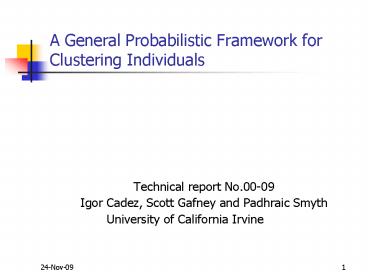A General Probabilistic Framework for Clustering Individuals - PowerPoint PPT Presentation
1 / 15
Title:
A General Probabilistic Framework for Clustering Individuals
Description:
Igor Cadez, Scott Gafney and Padhraic Smyth. University of California Irvine. 11/7/09 ... Scope of standard vector-based clustering. Probabilistic framework of ... – PowerPoint PPT presentation
Number of Views:33
Avg rating:3.0/5.0
Title: A General Probabilistic Framework for Clustering Individuals
1
A General Probabilistic Framework for Clustering
Individuals
- Technical report No.00-09
- Igor Cadez, Scott Gafney and Padhraic Smyth
- University of California Irvine
2
Overview
- Scope of standard vector-based clustering
- Probabilistic framework of generative mixture
models - Generative Mixture-Based Cluster Model
- Web Browsing example
- EM-based Clustering Algorithm for Clustering
Individuals - Web Browsing example
- Experimental results for the Web Browsing example
3
Standard Vector Based Clustering
- Not directly applicable to data that is a
non-vector form (sequences, time-series) - Different individuals can have different
amounts of observed data ( e.g. Web browsing
behavior, gene expression data) - How they got around it?
- Reduce observed data to vectors of fixed
dimensionality - Apply standard clustering techniques
- But, loss of information for sequential/temporal
data
4
Probabilistic Framework of Generative Mixture
Models
- Models non-vector data in its native form
- Handles multiplicities of data sizes and data
types across individuals - Expectation-Maximization (EM) algorithm quite
similar to the standard EM algorithm-but
different individuals have different effects on
the estimation depending on the number of
observations.
5
Generative Mixture-Based Cluster Model
- Draw an individual i from the overall population.
- The individual is assigned to one of K clusters
, with probability p(cik),
where ci indicates the
cluster membership. - Each cluster k, , has a data
generating model
- where Qk are the
parameters of pk - Di now generated for an individual by
- once cluster membership cik is known and
given Qk.
6
Web browsing example
- Each individual has a set Dis1,s2,,sniwhere
each s is a sequence that represent the observed
record of page requests for individual i and the
different sequences represent the different
sessions.
7
Web Browsing example (continued)
- The population of Web users is divided into K
clusters and a user i has a probability p(cik)
of belonging to cluster k. - Each cluster is modeled by a finite-state Markov
model with parameters Fk. (Prob. of a sequence s
for cluster k is - Number of session ni for each i follows a
geometric model with parameter lk and
distribution - Overall parameters consist of
8
Web Browsing example(continued)
- The probability of Di from each i on assuming
that i of a member of cluster k is -
-
- The probability of Di for i when ci is unknown
- The probability that i belongs to k (Bayes rule)
9
EM-Based Clustering Algorithm for Clustering
Individuals.
- Consider N individuals each having a data set Di
. Let each Di consist of ni observations dij.
Each dij represents another smaller data subset. - According to the generative cluster model each i
has a pdf where
QQ1,Q2 ,,Qk - and each ci is the cluster identity of the i
th individual - Assuming that the observations are conditionally
independent, the prob. that i belongs to ci is -
10
EM Based Clustering Algorithm (continued)
- To learn the ML or MAP estimates given D under
the assumption of data from different individuals
being conditionally independent we get - where QMLarg maxQp(DQ) and
- QMAParg maxQp(DQ)p(Q).
11
Web Browsing example
- Each individual i has ni sequences and we
consider a generative Markov model, having states
from 1 to M. - The model parameters fro each Markov cluster Qk
has an initial state probability pk(s) and a MXM
transition matrix Tk(s2s1), where s,s1,s2 denote
discrete states. - Let Disi,1,,s i,j,,si,ni be the data for the
i th individual where the subscript j denotes the
j th sequence for i. - The likelihood of si,j conditioned on any ci with
parameters Qci is
12
Web Browsing example (continued)
- The probability of all of the data Di from I,
conditioned on cluster ci is - The marginal probability given the model
parameter can be written as -
- where ak defines the proportion of the
component models.
13
Web Browsing example (continued)
- Given the definition of the likelihood function,
the EM procedure becomes - E step
- M step
14
Results of clustering
- Each square represents joint probability
p(si,sj). - Clustering Genes using Gene Expression Data
- -Real valued sequences as a
function of time - Clustering Patients based on Red Blood Cell
Cytograms - -Vector data variable number of data
points per person
15
Conclusion
- If one individual has more observations than the
other then that data will have more weight in the
parameter estimation. - Models heterogeneous data across different
individuals in a general framework - All available data on an individual can be used
without having to develop specialized algorithms































